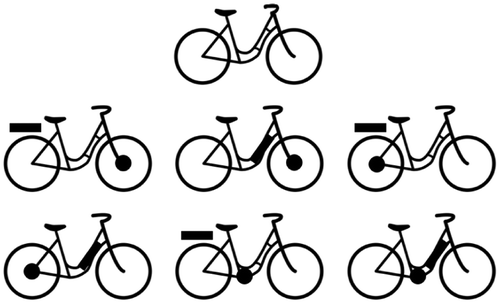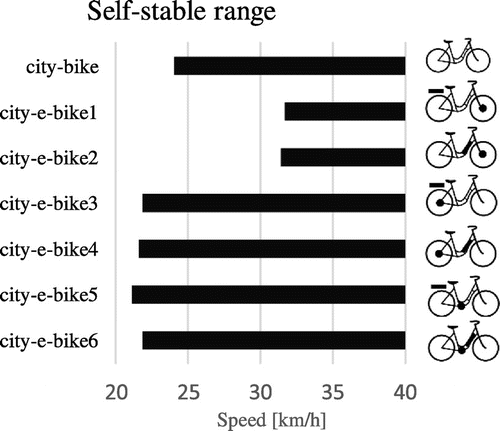 ?Mathematical formulae have been encoded as MathML and are displayed in this HTML version using MathJax in order to improve their display. Uncheck the box to turn MathJax off. This feature requires Javascript. Click on a formula to zoom.
?Mathematical formulae have been encoded as MathML and are displayed in this HTML version using MathJax in order to improve their display. Uncheck the box to turn MathJax off. This feature requires Javascript. Click on a formula to zoom.1. Introduction
Due to external factors such as lifestyle, traffic congestion and global warming, there is a renewed interest in cycling. In several cities bicycles outnumber cars. Advanced varieties appear, equipped with electrical power-assistance, storage container or extra seats for passengers.
Recent bicycle-configurations are created by trial and error, not taking riding stability into account, which is a very critical aspect of a safe and comfortable bicycle tour. In science, bicycle stability is the focus of numerous research. Carvallo (Citation1899) creates an introductory equation of bicycle motion and Whipple (Citation1899) examines the self-stability of a bicycle. They address that every bicycle is self-stable in a specific range of speed. If the cyclist does not interfere, a self-stable bicycle will not fall over and keeps on rolling straight forward. The Whipple-Carvallo model forms the basis of new stability research. Schwab and Meijaard (2013) expand the model to calculate the stability of a bicycle as a function of its design. Stability research focusses mostly on sports bicycles instead of recreational ones. Although, stability control is equally important for recreational bicycles, as a storage container, extra passenger or motor can disturb the stability drastically. Most likely, the risk of falling with an e-bike is higher than falling with a conventional one (Fietsberaad, 2013).
This research compares the difference in self-stability between a woman’s city-bike and a woman’s electrically power assisted city-bike (city-e-bike). If a bicycle is self-stable, the user does not need to stabilize the bicycle and the mental workload is reduced. Consequently, user’s controlling actions are taken out of consideration. Dieltiens (2017) illustrates that the cycling-posture of a woman’s city-e-bike differs from a manual one. The changed bicycle-design and the addition of the motor and battery have a notable impact on the mass values of the bicycle and the related cycling stability. D’hondt’s stability-program (2017) is employed to calculate the self-stability of seven traditional city-bikes. Acquiring information on modern city-bikes will shed a light on the actual risks of falling with an e-bike and will improve traditional bicycle design.
2. Methods
2.1 Subjects
A conventional female city-bike is compared to six standard city-e-bikes, distinguishing themselves only by motor- and battery position. The motor is located in the front wheel (city-e-bike 1,2), rear wheel (city-e-bike 3,4) or bottom bracket (city-e-bike 5,6), while the battery is located in the luggage rack (city-e-bike 1,3,5) or lower mid-tube (city-e-bike 2,4,6).
2.2 Calculations
The dimensions of a woman’s city-e-bike differs from a manual one. The steer of a city-e-bike is positioned higher and more to the front. The changed bicycle-design and the addition of the motor and battery on different locations have a notable influence on the mass moment of inertia and the position of the centre of mass. The seven bicycle configurations are modelled in Solidworks to calculate their mass, mass moment of inertia and the centre of mass.
Due to the differences in women’s e-bike- and manual bicycle-design, on average a cyclist notably sits more upright when riding a city-e-bike. Consequently, the mass moment of inertia and the centre of mass of the cyclist differ. Williams (Citation2015) describes the mass moment of inertia and the position of the centre of mass of an 82.15 kg weighted cyclist varying from an erect posture until an absolute aerodynamic one. The cycling-posture of a city-e-bike corresponds to his ‘relaxed’ model and the cycling-posture of a manual bicycle corresponds to his ‘on Hoods’ model. His values are utilised in our research.
2.3 Simulation
The stability model of Schwab and Meijaard (2013) determines the speed-range in which a bicycle is self-stable. According the model, a bicycle exists of four rigid bodies: the rear wheel, body and frame assembly, front handlebar and fork assembly and front wheel. Depending the type of bicycle and cyclist, the dimensions, mass, position of centre of mass and mass moment of inertia of each rigid body change. Based on these values, D’Hondt’s stability-program (2017) derives the M, C1, K0, K2 matrices for the stability model of Schwab and Meijaard (2013).
v = cycling speed
g = gravity constant
q, f = time-varying quantities
M, C1, K0, K2 = matrices defined by bicycle
design and the related mass values
The eigenvalues of the linearized fourth grade equation are plotted in function of the speed. Eigenvalues with a positive real part determine the unstable speed range of the bicycle, eigenvalues with a negative real part determine the stable speed range of the bicycle.
3. Results and discussion
The self-stability speed range starts between 21.1 and 31.7 km/h and reaches further than the maximal achievable cycling speed. Therefore, only the initial speed of the self-stable range is of importance.
The self-stable speed of a manual women’s city-bike starts at 24.4 km/h. Remarkably, four out of six e-bikes perform better than the manual bicycle. City-e-bike 5 performs best, his self-stability starts at 21.1 km/h. The self-stable speed of city-e-bikes 4, 3 and 6 start slightly later, respectively 21.6 km/h, 21.9 km/h and 21.9 km/h, though the difference with city-e-bike 5 is almost negligible (max 0.7 km/h). The difference with city-e-bike 1 and 2 is on the other hand tremendous. These city-e-bikes perform awful with a self-stable speed starting respectively at 31.7 km/h and 31.4 km/h.
The difference between a motor located in the rear wheel or bottom bracket is not noticeable, both have a positive effect on the self-stability of a bicycle. City-e-bikes with a motor located in the front wheel perform alarming. Most often they will not reach their stable modus, as the electrical assistance of most city-e-bike’s is limited to a maximal speed of 25 km/h. The influence of the location of the battery is negligible.
Knowledge about self-stability is necessary to improve bicycle-design regarding it is manual or electrically-power assisted. A low self-stable starting speed has a positive influence on cycling comfort considering no user’s interaction is required. Though, analyzing self-stability gives no information about the amount of forces a user has to induce if the bicycle is not stable. Further research is necessarily.
4. Conclusions
The self-stability of a bicycle upgrades when a motor is inserted in rear wheel or bottom bracket. A motor located in the front wheel degrades the self-stability. The location of the battery has little to no influence.
Acknowledgements
This study was facilitated by the department of Mechanics from the Technology campus Gent, KU Leuven.
References
- Carvallo E. 1899. Théorie Du Mouvement Du Monocycle Et De La Bicyclette, Gauthier-Villars, Paris, France.
- D’Hondt J. Calculating The Self-Stability of a Bicycle, submitted 2017.
- Dieltiens S. Differences in Posture Between a Manual and Electrically Power Assisted City- bike, submitted 2017.
- Meijaard J.P., Schwab A.L.. 2013. A Review on Bicycle Dynamics and Rider Control. Vehicle System Dynamics. 51:1059–1090.
- Whipple F, 1899. The Stability of the Motion of a Bicycle. Q J Pure Appl Math. 30: 312–348.
- Williams T, 2015. Influence of Frame Stiffness and Rider Position on Bicycle Dynamics: An Analytical Study, Theses and Dissertations Paper 985
- Feiten Over de Elektrische Fiets (Facts about the e- bike). Fietsberaad, Utrecht, The Netherlands (in Dutch)


